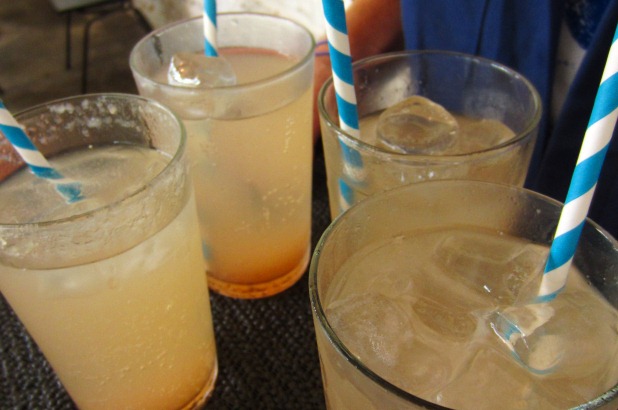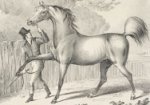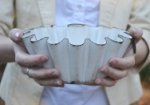The latest in the Real Food – Old Ways series at Vaucluse House delved into foraged foods and cocktails. We all enjoyed our drinks chilled with chunks of ice chipped straight from the block, and this raised the question of how drinks were chilled before refrigeration. You’ll be surprised how!
I’ve previously mentioned the name ‘cocktail’ in connection with mint juleps and eggnog. While it conjures up an image of American bars in the 1930s, it’s actually a much older word. Recent research [1] has found it referenced as early as 1798 in London, where a satirical article in the Morning Post and Gazetteer mentions a drink named a “‘cock-tail’ (vulgarly called ginger).” Jared Brown notes the old use of the word cock-tail to refer to a non-pedigreed horse. Unlike their more expensive counterparts, these horses had their tails cut short – or ‘cock-tailed’ – to denote their status. This definition is from 1829:
Horses, which appear as racers, and are understood not to be thorough-bred, are, in the common language of the turf, denominated Cocktails. They ran for Hunters’ Stakes, and also for what are called Half-bred Stakes; nor indeed are they debarred from running for regular plates, &c. for which, however, they seldom enter: though instances are not wanting where they have beaten acknowledged thorough-bred horses, and those of a fair description, or perhaps a little above the general average of what may be called plate horses…
C F Brown, The Turf Expositor, 1829
The chapter goes on to decry the substitution of Thoroughbreds for ‘cocktails’ in order to rig a race. The idea then is that ‘cock-tail’, as a term applied to a beverage, referred to it simply being a mixed drink, just as the cock-tailed horse was of ‘mixed’ parentage and not ‘pedigreed’. The slang word ‘ginger’ used in the 1798 quote supports this: ‘gingering’ was a rather unpleasant way of getting a horse animated for sale or racing. I wont go into the details…
“Cocktail” seems to enter the Australian vernacular with gusto during the gold rushes, when Californian miners flocked to Victoria. Pubs and Hotels quickly advertised “cocktails and kinds of American drinks”. As I’ve noted before, the big difference between, say, a punch recipe and a cocktail recipe is that while both are mixed drinks, the former is given in quantities to make whole bowl-fulls, cocktails are typically given in individual serves. It suggests them being ordered and served individually across the bar.
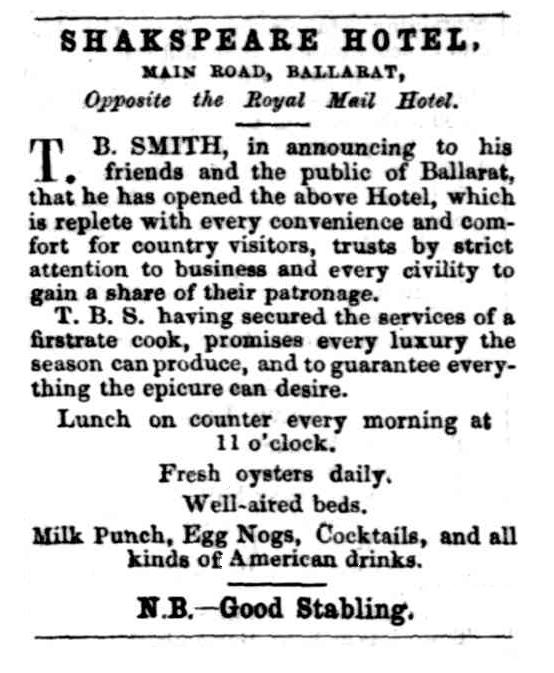
Advertisement for the Shakespeare Hotel, Ballarat, with references to milk punch, egg-nog and cocktails, The Star, 20 Sep 1856, page 3, viewed 18 Dec 2013, http://nla.gov.au/nla.news-article66039537
Ice! Ice! Ice!
But how do you chill a cocktail without ice? We’ve already written about the resourceful inhabitants of Meroogal and Rouse Hill setting jellies by lowering them into a cool well or cistern. But employing a cool cellar or well is still a far cry from ice or refrigeration. Amazingly, the first ice available in Sydney was imported all the way from Boston, cut from frozen rivers and transported in insulated ships. The first shipment arrived in Sydney on board the Tartar in January, 1839. The Sydney Herald wrote of the delivery, American mercantile ingenuity and the initially blase attitude of Sydney-siders.
ICE ! ICE! ICE ! – Plenty of ice in the Colony; yet it appears to excite no more interest than if the natives skated upon it every winter… The Americans are really speculative people; Here have they sent ice all the way from Boston – ICE! They shipped four hundred tons; and two hundred and fifty tons, at least, will he landed. They have sent it, in huge blocks, to Calcutta ; they have sent it to the Havannah ; they have sent ice to Botany Bay ‘. They turn even their frosty weather to advantage.
The implications of ice for food storage in a hot climate was not lost on the writer, who also notes that ice-boxes were also brought for sale. This was obviously not meant to be a one-off consignement:
…In America, as well as in the Indies and the Havannah, wine, cream, butter, water, meats – are all cooled with ice. It is brought to the doors of the houses in the United States, us commonly as other articles of domestic use. The Colonists here will do well to avail themselves of an indulgence in this luxury – for luxury it may well be called. In Sydney it may be obtained at any moment – while it lasts – and our fellow Colonists at Hunter’s River and at Parramatta, may procure a share by means of the steam-boats. The Tartar has also brought a number of refrigerators, so constructed that wine, meat, butter, &e. can be kept at Zero temperature.
The Sydney Herald, Monday 21 January 1839
So all those wonderful recipes for chilled wines, champagnes and desserts were again in reach – at least for the wealthy. Marvelous objects like this cooler from Elizabeth Bay House – one of my favorite objects in all of Sydney Living Museums collections – could be pressed into service, with crushed or shaved ice placed in its outer container, and a champagne bottle or even ice cream served inside.
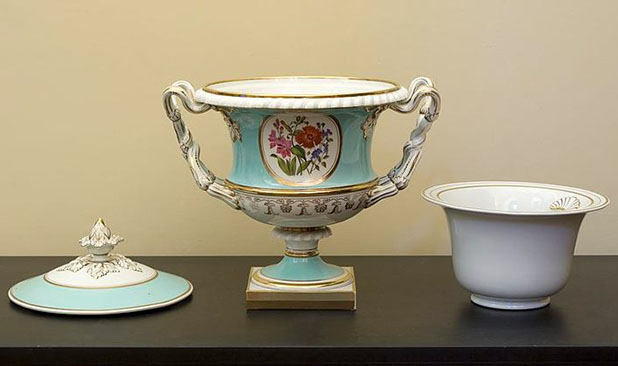
Wine cooler by Flight, Barr & Barr, c1820-25. Caroline Simpson Collection, Sydney Living Museums EB2005/6-37:39
In cooler Tasmania the option of an ice-house stocked with local ice and snow from Mt Wellington was realised in the early 1850s, one author writing “the citizens are delighted at a trifling cost with a luxury only properly appreciated by a panting polka dancer or the restless fever patient whose temples are cooled by the delicious application of the ice.” [2]
The international trade in ice had its ups and downs, and continued for a while after mechanical means of production were introduced in the mid century. Early methods used a chemical reaction to create the low temperatures needed to freeze water – in the same way as instant hot or cold packs in a first aid cabinet work today. This design for E.D. Nicolle and Thomas Mort’s ‘Patent revolving freezer’ uses a ‘freezing midium [sic]’ in the inner chamber, against which a rotating drum moves water. The thin layer of ice that formed on the drum was then shaved off, falling into a second chamber where it was compressed by hydraulic rams into a solid block:
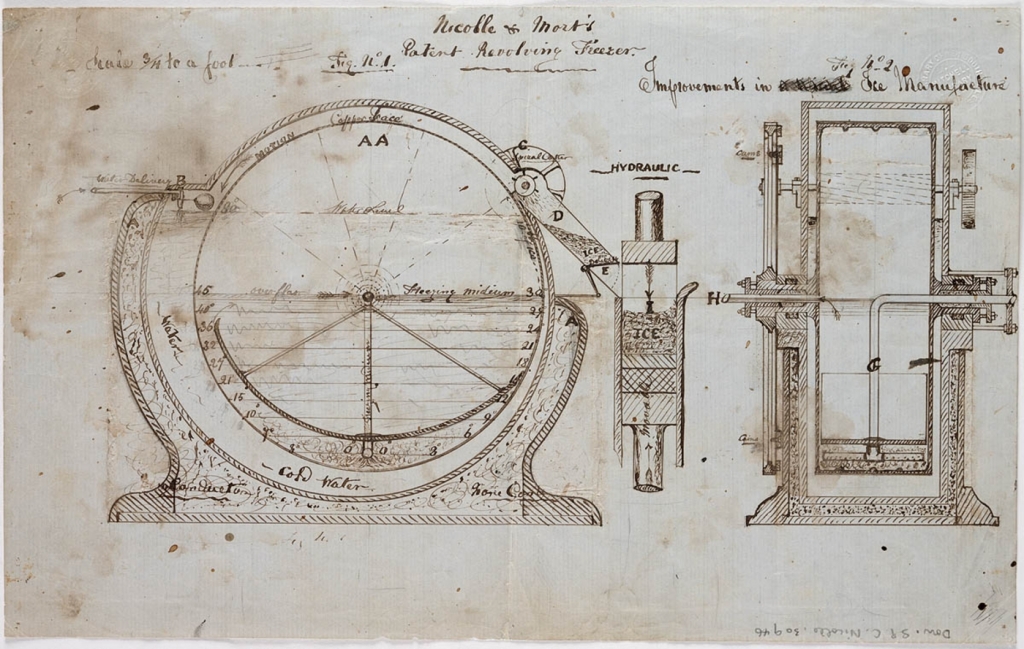
Design for an ice making machine, which worked on a chemical reaction to produce the freezing temperatures required. E.D. Nicolle – miscellaneous papers, including E.D. Nicolle’s passport and articles relating to refrigeration engineering, ca. 1851-1910. State Library of NSW A 2751
In 1855 the worlds first mechanical ice machine was patented by James Harrison in Geelong, Victoria, which he then developed in London. Successful demonstrations in 1858 led to it beginning operation in Sydney in 1860. The era of the ice chest, domestic refrigeration and refrigerated transport had well and truly begun.
Cobblers!
As can be seen from many early ‘cocktails’, the novelty of the drink being chilled or served on ice was often its main selling point. Many, like the ‘cobblers’ were actually very simple drinks. “Like the julep” wrote Jerry Thomas in 1862, “this delicious potation is an American invention, although it is now a favorite in all warm countries. The ‘cobbler’ does not require much skill in compounding, but to make it acceptable to the palate, it is necessary to display some taste in ornamenting the glass after the beverage is made.” Last Sunday we tried a cobbler of aromatic gin with syrup infused with foraged plants, in a glass with a large, single piece of ice. Delicious.
So to toast the international trade in ice, and James Harrison’s ice machine, here are two simple recipes. The first is for a ‘cobbler’, taken from the 1862 “How to mix drinks, or the Bon-Vivants Companion”. This was a drink exceedingly popular in bars in Sydney, Melbourne and right across the gold fields – perfect for a cashed-up thirst. There are numerous variations, simply substitute brandy, rum, or sweet wines such as a moselle or sauterne. The second is for a ‘brandy cocktail’, which the author described as “generally used on fishing and other sporting parties, though some patients insist that it is good in the morning as a tonic”. As one does. Cheers!
SHERRY COBBLER
2 wine glasses of sherry [for a whiskey or brandy cobbler just substitute].
1 tablespoon of sugar.
2 or 3 slices of orange.Fill a tumbler with shaved ice, shake well, and ornament with berries in season. [serve with a straw]
Fill a glass with shaved ice, add 2 jiggers (3 ounces) spirits (whisky, brandy or rum), or wine (sherry, a sweet German wine, Bordeaux or Sauterne), add 1 teaspoon of sugar dissolved in little water. Ad 2 or 3 orange slices and serve with a straw. Simple!BRANDY COCKTAIL
3 or 4 dashes of gum syrup [see notes]
2 dashes of bitters
1 wine glass of brandy
1 or 2 dashes of CuracaoSqueeze lemon peel [to release the lemon oils, then add peel to glass], fill one third of ice, stir with a spoon.
Notes and further reading
[1] Jared Brown & Anistatia Miller’s Spirituous Journey: A History of Drink. Mixellany Limited (2009), Vol.2.
[2] “The Ice House by H.M.H.” , The Hobart Town Daily Mercury, Saturday 10th July, 1858, p5.
Read Jared Brown’s “The surprising history of the cocktail”, The Telegraph online, Dec 12, 2013 http://www.telegraph.co.uk/luxury/travel/1256/the-surprising-history-of-the-cocktail.html Website retrieved 14 Feb 2014.
Jerry Thomas’ How to mix drinks, or the Bon-Vivants Companion, New York, Dick & Fitzgerald, 1862, is available online at Google Books and Project Gutenberg.
The Turf Expositor; containing the origin of horse racing, breeding for the turf, training, trainers, jockeys; cocktails, and the system of cocktail racing illustrated.
C. F. Brown. London, sherwood, gilbert, and piper, 1829, available online at Google Books.
An excellent article by Nigel Isaacs on the history of ice in Sydney can be read at the Dictionary of Sydney.
Gum syrup? Also called ‘gomme syrup’ this is a sweetener that adds much to the texture of a drink and also knocks down the effect of drinking what is pretty much straight alcohol. You could just use sugar syrup, or to be authentic use actual gum arabic, which you can get from herb and spice shops. Simply make a mix of the gum arabic ‘lump’ with an equal amount of boiling water to dissolve. Add that to your sugar syrup, made of 1 part water to 2 parts sugar. ‘Bar’ syrup is typically 1:1 water to sugar. Thomas also gives a recipe for gum syrup, but with commercial quantities of 20 pounds of gum arabic, 60 pounds of sugar and 5 gallons of water that would make a lifetime’s supply! His final ratio however suggests a mix of around 4 parts dissolved gum Arabic to 1 part sugar syrup. Remember that the cocktail recipe only takes a few dashes.
I have noticed that rather a lot of my posts seem to concentrate on booze. And why not I say! Huzzah!
